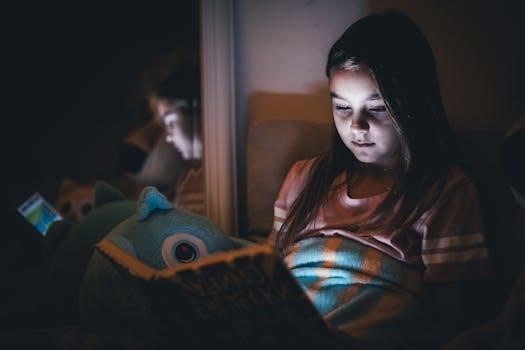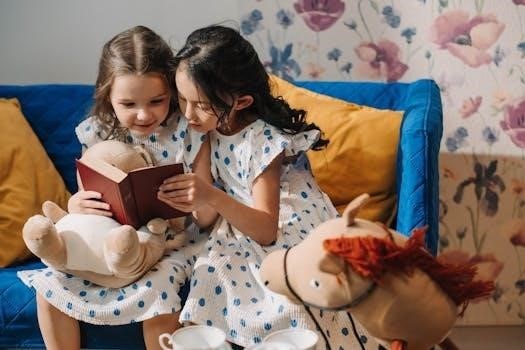Overview of “We’re Going on a Bear Hunt”
“We’re Going on a Bear Hunt” is a popular children’s book detailing a family’s exciting adventure. They bravely navigate through various terrains, seeking a bear, illustrating courage and determination.
Synopsis of the Story
“We’re Going on a Bear Hunt” follows a family’s thrilling expedition to find a bear. The story begins with a declaration of bravery and excitement, “We’re going on a bear hunt! We’re going to catch a big one!” They set off, encountering various landscapes, including long, wavy grass, a deep, cold river, thick, oozy mud, a dark, gloomy forest, and a swirling, whirling snowstorm.
At each obstacle, the family confidently proclaims, “Can’t go over it, can’t go under it, oh no! We’ve got to go through it!” This repetition creates a rhythmic and engaging narrative. Finally, they reach a narrow, gloomy cave, where they encounter a bear. Scared, the family reverses their journey, retracing their steps through each obstacle until they are safely back home, hiding under the covers.
Author and Illustrator Information
“We’re Going on a Bear Hunt” is a celebrated children’s book penned by the acclaimed British author Michael Rosen. Rosen is renowned for his engaging storytelling style and contributions to children’s literature, often incorporating rhyme, rhythm, and interactive elements into his works. His ability to connect with young audiences has made him a beloved figure in the world of children’s books.
The captivating illustrations that bring the story to life are the work of Helen Oxenbury, a highly respected illustrator known for her expressive and heartwarming depictions of characters and scenes. Oxenbury’s illustrations perfectly complement Rosen’s text, capturing the adventurous spirit of the family and the various environments they encounter. Her use of watercolor and attention to detail create a visually rich and immersive experience for readers.
Numerous websites offer “We’re Going on a Bear Hunt” as a free PDF download. These versions are often used for educational purposes and storytime sessions.
Free PDF Downloads
Many websites offer “We’re Going on a Bear Hunt” as a free PDF download, making it easily accessible for parents and educators. These free versions are often used for storytime sessions and classroom activities. Several sites provide scanned copies of the book, while others offer adapted versions suitable for interactive reading.
Finding a free PDF allows users to enjoy the story without purchase, promoting literacy and reading engagement. However, users should be mindful of copyright and ensure the source is reputable to avoid copyright infringement. Some educators, like Carolyn Wilhelm from The Wise Owl Factory, provide free PDFs attached to PowerPoint presentations for retelling purposes. These resources enhance the learning experience and make the book more engaging for children. Always check the source to ensure the PDF is legally shared for educational use.

Availability of “We’re Going on a Bear Hunt” in PDF Format
Where to Find Legal PDF Versions
Finding a legal PDF version of “We’re Going on a Bear Hunt” is essential to respect copyright and support the author and illustrator. Legitimate sources often include official publisher websites like Simon & Schuster, where the book is published. Digital bookstores such as Amazon, Google Play Books, and Apple Books also offer authorized PDF versions for purchase.
Educational platforms may provide legal access to the PDF as part of their subscription services, ensuring educators have the right to use the material in their classrooms. Libraries sometimes offer digital lending of the book via PDF through their online platforms. Always verify the source’s credentials and check for copyright notices to ensure the PDF is legally obtained and distributed. This approach supports creators and ensures access to high-quality, authorized content. By seeking legal versions, readers contribute to the continued creation of valuable literary works.
Educational Resources Based on the Book
PowerPoint presentations are available to help retell “We’re Going on a Bear Hunt,” aiding in story comprehension and engagement in educational settings.
PowerPoint Presentations for Retelling
Engage students with interactive PowerPoint presentations designed for retelling “We’re Going on a Bear Hunt.” These resources often include visuals, sound effects, and interactive elements to enhance the storytelling experience. Teachers can utilize these presentations to facilitate discussions about the story’s sequence, characters, and settings. The presentations frequently come with attached PDF versions of the book, making it easier to follow along.
Carolyn Wilhelm, from The Wise Owl Factory, offers free PowerPoint resources for educators. These presentations are designed to support retelling and comprehension activities. The slides can be customized to suit different learning styles and classroom needs, promoting active participation and creative expression. These materials are valuable tools for bringing the beloved story to life in an engaging and educational manner.
Story Maps and Activity Sheets
Enhance comprehension of “We’re Going on a Bear Hunt” with story maps and activity sheets designed to reinforce key plot elements. Story maps visually outline the sequence of events, helping children understand the narrative structure. These maps often include spaces for students to draw or write about each setting and challenge encountered during the bear hunt.
Activity sheets provide opportunities for creative expression and critical thinking; These may include matching exercises, sequencing activities, and fill-in-the-blank questions focusing on vocabulary and characters. Such resources are available online for free download, offering educators and parents valuable tools to support learning. These tools facilitate a deeper engagement with the story, encouraging children to actively participate in their reading experience. The activities make learning fun.

Themes and Learning Opportunities
“We’re Going on a Bear Hunt” explores themes of bravery and family adventure. It offers learning opportunities in language development, recall, and rhythmic call-and-response reading, engaging young learners.
Call and Response Reading
“We’re Going on a Bear Hunt” is exceptionally well-suited for call and response reading, a dynamic method that enhances engagement and participation. The repetitive nature of the text, with its rhythmic phrases and sound effects, makes it ideal for interactive storytelling. In this approach, a leader reads a portion of the text, and the audience responds with a specific phrase or sound, fostering a sense of shared experience.
This call-and-response format not only captures the children’s attention but also reinforces memory and comprehension. As participants echo key lines like “We’re going on a bear hunt!” and imitate sounds such as “Swishy swashy!” for grass or “Splash splosh!” for water, they actively immerse themselves in the story’s narrative. This active involvement transforms reading into a lively, communal activity, encouraging children to anticipate what comes next and strengthening their connection to the story. It’s a fun way to build literacy skills while enjoying a classic tale.
Vocabulary and Language Development
“We’re Going on a Bear Hunt” provides rich opportunities for vocabulary and language development in young children. The book uses descriptive language to paint vivid pictures of different environments, exposing children to new words and sensory experiences. Phrases like “long, wavy grass,” “deep, cold river,” and “dark, gloomy forest” introduce adjectives and descriptive terms that enhance their vocabulary.
The repetitive structure of the story also helps reinforce language patterns and sentence construction. As children hear and repeat phrases, they internalize correct grammar and syntax. The onomatopoeic words, such as “swishy swashy,” “splash splosh,” and “squelch squerch,” engage their auditory senses and help them connect sounds with actions. Furthermore, the book can be a springboard for discussions about synonyms, antonyms, and the use of figurative language, expanding their understanding of word relationships and nuances. This makes “We’re Going on a Bear Hunt” an excellent resource for boosting language skills.

Adaptations and Related Works
“We’re Going on a Bear Hunt” has inspired various adaptations and similar themed books, like “Bear Hunt” by Anthony Browne and other “We’re Going on a…” variations.
“Bear Hunt” by Browne Anthony
Anthony Browne’s “Bear Hunt” offers a distinct narrative, separate from the Rosen-Oxenbury classic. Browne, known for his surreal and thought-provoking illustrations, presents a different take on the bear hunt theme. While Rosen’s version emphasizes family adventure and overcoming obstacles through rhythmic language, Browne’s approach often incorporates deeper psychological elements and visual metaphors. His books frequently explore themes of identity, family dynamics, and the power of imagination.
“Bear Hunt” by Browne might delve into the hunter’s motivations and the bear’s perspective, creating a more nuanced and potentially unsettling experience. Browne’s illustrations are rich with detail and symbolism, inviting readers to interpret the story on multiple levels. This adaptation distinguishes itself by offering a more introspective and visually complex exploration of the “bear hunt” concept.
“We’re Going on a Lion Hunt”
“We’re Going on a Lion Hunt” serves as a thematic variation, drawing inspiration from the structure and rhythm of “We’re Going on a Bear Hunt.” This adaptation typically retains the call-and-response format, inviting audience participation and creating an engaging reading experience. However, instead of encountering a bear, the characters embark on a quest to find a lion, navigating different African landscapes or terrains.
The settings might include tall savanna grass, a wide river, muddy swamps, and a dark jungle, culminating in the discovery of a lion’s den. The story maintains the element of surprise and potential fear, as the characters ultimately retreat from the lion, mirroring the original’s narrative arc. This adaptation offers a familiar yet fresh experience by introducing new vocabulary related to African wildlife and environments.

Copyright and Permissions
Copyright of “We’re Going on a Bear Hunt” rests with the author and illustrator. Educational use is often permitted, but reproduction requires explicit permission from the copyright holders.
Usage for Educational Purposes
“We’re Going on a Bear Hunt” is widely used in educational settings due to its engaging narrative and repetitive structure, facilitating learning. Teachers often incorporate the book into lessons focusing on literacy, language development, and sequencing. The call-and-response nature of the text makes it perfect for interactive reading sessions, encouraging student participation and enhancing comprehension.
Educators frequently create supplementary materials like story maps and activity sheets to reinforce key concepts and vocabulary. PowerPoint presentations are also utilized to retell the story visually, aiding in memory retention and comprehension. The book’s themes of bravery and perseverance provide valuable life lessons for young readers. Worksheets are available, with content covering sequencing, vocabulary, and comprehension questions.
Using the book for educational purposes is generally accepted, promoting literacy and engagement.
Obtaining Permissions for Reproduction
Reproducing “We’re Going on a Bear Hunt” or its components generally requires obtaining permission from the copyright holders, Michael Rosen (author) and Helen Oxenbury (illustrator), or their respective publishers, Simon & Schuster. This is essential to respect copyright laws and avoid infringement.
For educational purposes, limited use might be permitted under fair use guidelines, but creating derivative works or distributing copies necessitates formal approval. To secure permissions, contacting the publisher directly is advisable. The request should clearly state the intended use, the extent of reproduction, and the distribution method.
Permissions are crucial for creating adaptations, translations, or commercial products based on the book. Obtaining these rights ensures legal compliance and acknowledges the creators’ intellectual property. Failure to secure proper permissions could result in legal consequences.
